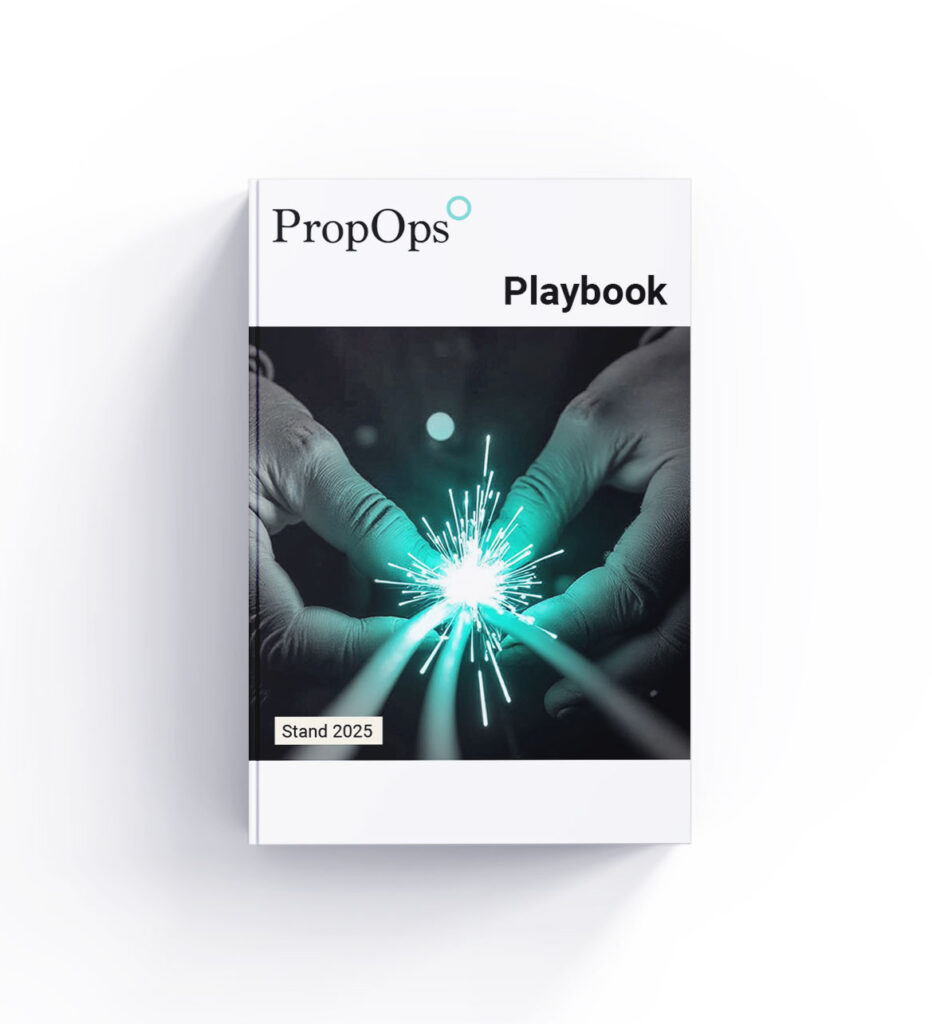PropOps für
Real Estate Consultants
PropOps digitalisiert das REIM und CREM durch das Sammeln und Visualisieren von Betriebsdaten
PropOps für Consultants
Heben wir gemeinsam den Datenschatz Ihrer Kunden.
Unsere Produkte PropOps Comply und PropOps Connect erweitern Ihr Portfolio an Consulting-Leistungen. Mit unserer Software-Schmiede PropOps Create können wir auch maßgeschneiderte Lösungen für Ihre Bedarfe schaffen.
PropOps Create
Maßgeschneiderte Apps
Wie schreite ich mit der Digitalisierung fort, wenn der Grundstein gelegt ist? Der wirkliche Spaß beginnt erst jetzt: Entlastung von Mitarbeitern, Optimierung bestehender Prozesse, Ausschöpfung von Digitalisierungspotenzialen und Abbildung von Unternehmensknowhow.
PropOps Create hilft Ihnen dabei und entwickelt individualisierte oder gar individuelle Apps, die auf der Datendrehscheibe von PropOps Connect und den Scheckheften und Bots von PropOps Comply aufsetzen.


So führen Sie PropOps in Organisationen ein
Der Rollout von Software ist oft der sensibelste Moment im gesamten Projekt. Dank unserer langjährigen Erfahrung begleiten wir Sie und Ihre Kunden zuverlässig durch diesen Prozess und gestalten die Einführung passgenau nach Ihren Anforderungen. Für Beratungsunternehmen empfehlen wir zwei Einführungsszenarien, die sich in der Praxis für eine erfolgreiche Implementierung von PropOps bewährt haben.
Einführungsszenario 1
Funktionale Strategie
"Eins nach dem anderen" ist sicher nicht der verkehrteste Ansatz. In diesem Szenario schließt PropOps die Dienstleister an PropOps Connect an und stellt in PropOps Comply die entsprechenden Scheckhefte aus. Dabei liegt der erste Fokus auf der Dokumentation von Prüfungen und Wartungen, der zweite auf dem Soll-Ist-Vergleich zwischen tatsächlich eingeplanten und abgearbeiteten Aufträgen und dem jeweiligen Prüf- und Wartungsplan und zum Schluss auf der Mangelnachverfolgung.

Es ist bereits ein bedeutender Schritt, einen Überblick sämtlicher Wartungen und Prüfungen über das Portfolio hinweg zu haben. Und das schon in der Planungsphase. Der entsprechende Bot von PropOps Comply überwacht dabei die Termintreue und die vereinbarte Dokumentation.

Erst mit dem Soll-Ist-Vergleich aus identifizierten Pflichten und tatsächlich eingeplanten Wartungen und Prüfungen ergibt sich ein allumfassendes Bild der Compliance Ihres Gebäudebetriebs. Vorbei sind die Zeiten von veralteten Excel-Listen mit bunt markierten Zellen. Der Prüfungs-Bot verknüpft Aufträge mit Pflichten automatisch und zeigt Schwachstellen auf.

Pflichten enden nicht bei durchgeführten Wartungen und Prüfungen. Mängel müssen identifiziert und in vorgegebener Zeit dokumentiert abgestellt werden. Mit dem PropOps eigenen Bot zur Mangelnachverfolgung wird das nun transparent möglich.
Einführungsszenario 2
Organische Strategie
Bleibt keine Zeit für ein funktionales Ausrollen von PropOps Comply, weil der Schuh lokalisierbar drückt, so bietet sich die Einführung nach Priorität von Objekten und Teilportfolien an. Dabei werden die Scheckhefte Schritt für Schritt in PropOps Comply freigeschaltet, um die wichtigsten Pain Points bspw. vor oder nach einem Audit oder in einer Due-Diligence-Phase zu lindern, anschließend Probleme in spezifischen Clustern zu beseitigen und zur guter Letzt das ganze Portfolio abzudecken.

Manchmal braucht es den Fokus auf bestimmte Einzelobjekte, um die größten Herausforderungen konzentriert abzustellen. Erst danach kann sich um die Digitalisierungsstrategie gekümmert werden.

Auch die Abdeckung ganzer Portfolios kann schrittweise erfolgen. Machmal lohnen sich Cluster nach Dienstleister, Fond, oder der Fokus auf ein spezielles Teilportfolio bzw. der Rollout nach Region.

Am Ende befindet sich das Gesamtportfolio übersichtlich in PropOps. Alle Akteure haben eine gemeinsame Datenbasis, um an den gesteckten Zielen im Gebäudebetrieb zu arbeiten.
Volle Transparenz, alle Möglichkeiten
Schnittstellen-Dokumentation
Unsere REST-API ist offen dokumentiert. Unter https://connect.propops.com/ finden Sie und Ihre technischen Mitarbeitenden Authentifizierungsmechanismen, verfügbare Routen, Beispielrückgaben, und die Ausgestaltung der Objekte und Attribute.
-
Authentifizierung über OAuth 2.0
-
100% Dokumentation ist Teil des Playbooks
-
100% Feature-Abdeckung
-
Basis für PropOps Comply

Blockchain
Wir glauben nicht an Technologie als Selbstzweck, sondern an ihren sinnstiftenden Einsatz.

Datenaggregation
PropOps aggregiert und homogenisiert Ihre Betriebsdaten in der Cloud. Dabei ist durch eine sorgfältige Backup-Strategie und eine Revisionierung aller Daten sichergestellt damit nichts verloren geht.

Fingerprinting
Von jedem durch PropOps erfassten Datum wird ein mathematischer Fingerabdruck, ein sogenannter Hash genommen und in die Blockchain (Permanent Node des DLT) der IOTA Foundation in Berlin gespeichert. Wie beim menschlichen Fingerabdruck kann lediglich die Identität der Daten mit diesem Abdruck verifiziert werden, die Daten selbst sind darin nicht enthalten.

Manipulations-sicherheit
Im Zweifelsfall kann von einem Datum aus PropOps, bspw. einem Dokument, erneut ein aktueller Fingerabdruck genommen und anschließend mit dem ursprünglichen Fingerabdruck in der Blockchain verglichen werden. Stimmen die beiden Fingerabdrücke überein, so lässt sich technisch zweifelsfrei nachweisen, dass das entsprechende Datum seit der Aggregation in PropOps nicht manipuliert wurde.

Komfortables Onboarding
Das PropOps Playbook
Im Rahmen zahlreicher Anbindungen und Betriebsprojekte hat PropOps über die letzten Jahre eine Reihe von Bausteinen entwickelt, die heute den Kern unseres Playbooks bilden:
Mindestanforderungen an Datenlieferungen
Erprobte Textbausteine für die Vertragswerke für FM-Ausschreibungen
Laufend gepflegte Datenbank über FM-Dienstleister und deren Systeme
Praxiserprobtes Vorgehen für Startup-Phasen im FM-Betrieb
Beispiel-Zeitpläne und Datenflussdiagramme
Muster für Lizenzvereinbarungen zwischen PropOps und den Dienstleistern
Standard-Dashboards und Berichtsformate
Strukturierte Entwicklungsprozesse für neue Funktionen
Technische Dokumentation zu PropOps Connect
Automatisiertes Monitoring, Berichtsintervalle, Eskalationswege und Reportings
Strukturiertes Schulungsmaterial und eingespielter Supportprozess – dokumentiert und SLA-fähig
Datenschutzunterlagen und IT-Sicherheitsdokumentation

